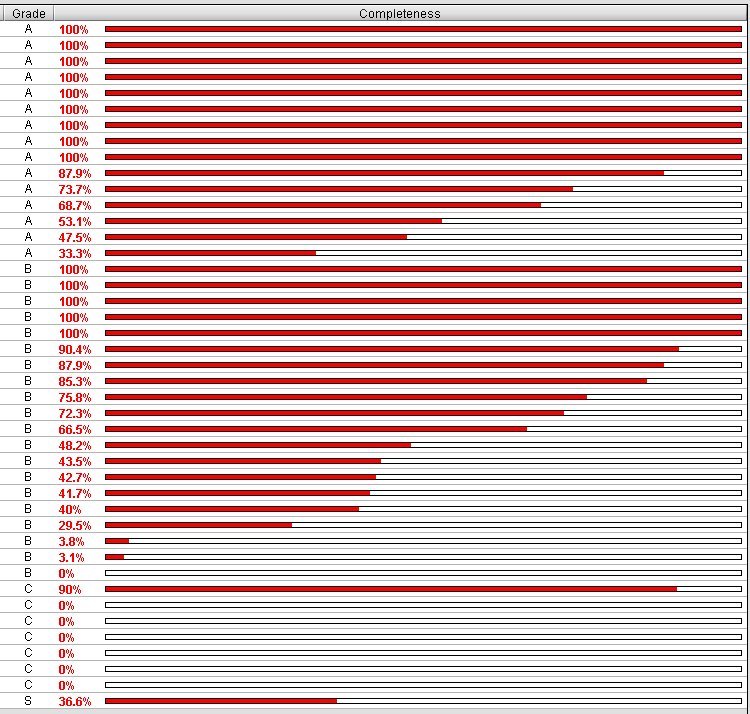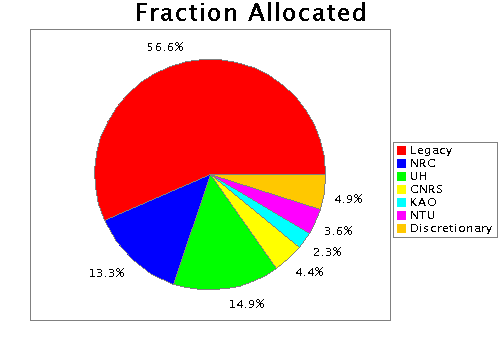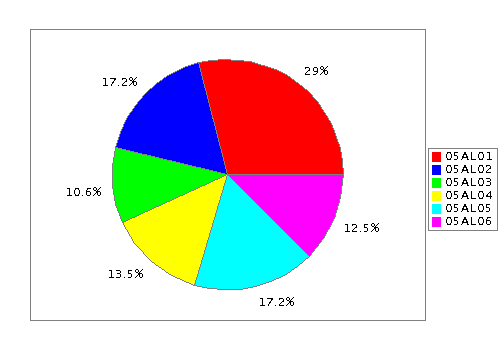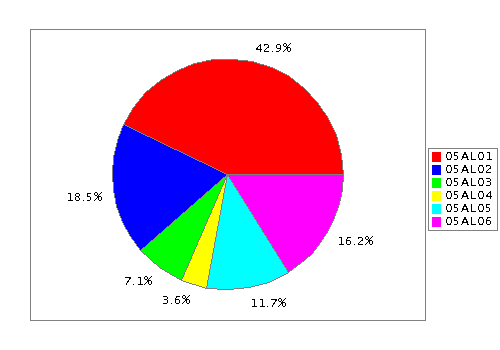
Queued Service Observing with MegaPrime:
Semester 2005A Report
08/22/05


|
Queued Service Observing with MegaPrime: Semester 2005A Report 08/22/05 |

|
A - Introduction
The Queued Service Observing (QSO) Project is part of a larger ensemble of software components defining the New Observing Process (NOP) which includes NEO (acquisition software), Elixir (data analysis) and DADS (data archiving and distribution). The semester 2005A was the fifth semester for which MegaPrime was used within the NOP system and unfortunately, it was a tough one. Weather was not good for most of the semester (except at the end). Again, the 2005A semester was extremely complex on the scheduling process since several programs requested time constraints. We worked really hard to make sure that everything fits as much as possible which was not an easy task with the uncooperative weather! They are, however, two very positive development that occurred during this semester: 1) The guide probes motion were sped up by about a factor of 10, greatly reducing the overheads associated to guiding acquisition. 2) A focus model based on the temperature of the telescope truss and position was implemented; the number of focus sequences has now been reduced significantly so observing efficiency there has also improved. In 2005B, we will also start operating WIRCam in a queue mode so it's going to be another challenge, with CFHT being operated in queue mode for ~300 nights per year....
B - General Comments
The 2005A semester
was quite difficult due to significant time lost to bad weather and technical
problems. The weather in the first part of the semester was horrendous;
we lost about 75% of the time during the first 3 runs! The middle of the
semester was a bit better which allowed us to catch up a bit on some programs.
the end was also difficult with extended periods of bad seeing.
The semester 2005A included a lot of very difficult scheduling issues
related again to the presence of several PI programs with some time critical
observations; in the context of CFHTLS which represented 56% of the total
time in QSO, this added considerable complexity to the scheduling process.
A positive aspect of the 2005A is the improve observing efficiency due to
reduction of the overheads by the guide probe motion and focus sequences.
Some general remarks on QSO in general for the semester 2005A:
1. Technically, the entire chain of operation, QSO --> NEO --> TCS, is efficient and robust. The time lost to the NOP chain is very small. This is a complex system and we have worked real hard to reduce the overheads on this. Glitches appear from time to time, mostly on the guide star acquisition, but the system is quite reliable and efficient.
2. The QSO concept is sound. With the possibility of preparing several queues covering a wide range of possible sky conditions in advance of an observing night, a very large fraction of the observations were done within the specifications. The ensemble of QSO tools allows also the quick preparation of queues during an observing night for adaptation to variable conditions, or in case of unexpected overheads. The introduction of the CFHTLS and several other PI programs with time constrained observations on a large-scale adds significant complexity to queue scheduling and requires much more work on planning of the runs. For 2005A, the global validation rate (validated/observed) was good but not as high as we had wanted due to very unstable weather. A discussion on this is included in section C.
3. QSO is well adapted for time constrained programs. The Phase 2 Tool allows the PIs to specify time constraints. Two of the components of the CFHTLS have very restrictive time constraints. We can handle those easily if the weather is cooperative (of course!) although the introduction of time constrained observations on a large-scale adds up definitive complexity in the scheduling process.
4. Very variable seeing and non-photometric nights represent the worse sky conditions for the QSO mode. In 2005A, we were still a bit short on "shapshot" programs or regular programs requesting mediocre conditions (1" to 1.2"). As a result, we were often forced to observe programs in conditions worse than requested, mostly by the end of the semester. Again, we were able to calibrate all the fields requesting photometry but originally done during non-photometric conditions. The availability of Skyprobe and real-time measurements of the transparency is extremely valuable and regularly used do decide what observations should be undertaken.
5. Observations of moving targets is feasible in a queue mode. During the 2003A semester, we implemented a way of preparing observations for moving targets in our Phase 2 Tool (ephemeris tables). The process is a bit laborious but works really well and several programs have used this option again for 2005A as well. Non-sidereal guiding is not yet offered.
C - Global Statistics, Program Completeness, and Overheads
1) Global Statistics
The following table presents some general numbers regarding the queue observations for 2005A (C, F, H, K, L, and T, D-time, excluding snapshot programs). Note: 1 night is 9.5 hours.
|
Parameter
|
Number
|
| Total number of Nights |
104
|
| Nights lost to weather |
~34 (~33%)
|
| Nights lost to (engineering + technical) problems |
~ 7 (~7%)
|
| QSO Programs Requested |
43 (+ 1 snapshot)
|
| QSO Programs Started | 38 |
| QSO Programs Completed | 14 |
| Total I-time requested (hr.) |
668
|
| Total I-time validated (hr.) |
399 (67%)
|
| Queue Validation Efficiency |
~ 87 %
|
Remarks:
2) Program Completeness
The figure below presents the completion level for all of the programs
in 2005A, according to their grade:

Remarks:
3) Overheads
The following table include the main operational overheads (that is, other than readout time of the mosaic) with MegaPrime during the second part of semester 2005A. In the second part of 2005A, modifications were made to the guiders (software and hardware) and an autofocus model was implemented, considerably reducing the number of focus sequences needed during a night. This is given as a reference; overheads are highly variable during a given night depending on the conditions, complexity of science programs, etc. globally, the operational overheads constitute now about 15% of an observing night, the number originally expected before MegaPrime observations started.
|
Event
|
Events/night
|
Overhead
|
Total overhead per night
|
| Filter Change |
15 - 25/ night
|
90s /change
|
1500 - 2200 seconds
|
| Focus Sequence |
~ 3 / night
|
200s / seq
|
600 seconds
|
| Dome Rotation > 45 d |
5 ?
|
120s
|
< 600 seconds
|
| Guide Star Acquisition |
20 - 30 ?
|
20 s / acq
|
< 600 seconds
|
Remarks:
D - Agency Time Accounting
1) Global Accounting
Balancing of the telescope time between the different Agencies is another constraint in the selection of the programs used to build the queues. The figure below presents the Agency time accounting for 2005A. The top panel presents the relative fraction allocated by the different agencies (program A + B), according to the total I-time allocated from the Phase 2 database. The bottom panel represents the fraction of observations validated (programs A+B+C) for the different Agencies, that is, [Total I-Time Validated for a given Agency]/[Total I-Time Validated]. As showed in the plots, the relative distribution of the total integration time of validated exposures between the different Agencies was balanced at the end of the 2005A.

|

|
Remarks:
2 ) CFHTLS Accounting
The following figures show the time accounting for the different CFHTLS components:


Since each component of the survey is divided into two programs, the global fractions are given in the following table:
|
Survey
|
Programs
|
Fraction Requested
|
Fraction Validated for 2005A
|
| Deep Synoptic | L01 + L04 |
29 % + 13.5% = 42.5%
|
42.9% + 3.6% = 46.5%
|
| Wide Synoptic | L02 + L05 |
17.2% + 17.2% = 34.4%
|
18.5% + 16.2% = 34.7%
|
| Very Wide | L03 + L06 |
10.6% + 12.5% = 23.1%
|
7.1% + 11.7% = 18.8%
|
Remarks:
E - Conclusion
Our fifth semester with the queue mode with MegaPrime was rather average. The fraction lost to bad weather was way too high. however, the encouraging news are that the overheads were significantly reduced in the second part of the semester so the observing efficiency is now much higher than previously. The completion level is a bit on the lot side for 2005A. The Queue validation rate was quite good despite the bad conditions and balance of the Agencies was quite satisfying. The balance between the LS surveys was much better this time around.
| Copyright (c) CFHT. All rights reserved. This page was last modified on: Wed, 11 Aug 2004 03:31:56 GMT Comments to: "website at cfht.hawaii.edu" |
Home, News, Observing, Science, Images, Outreach, OurUsers |